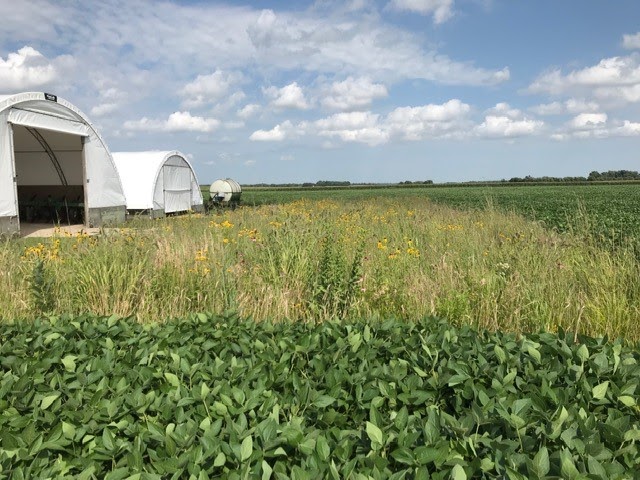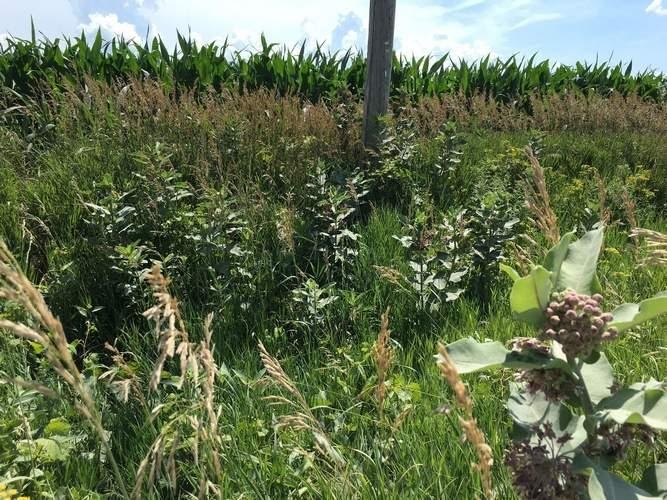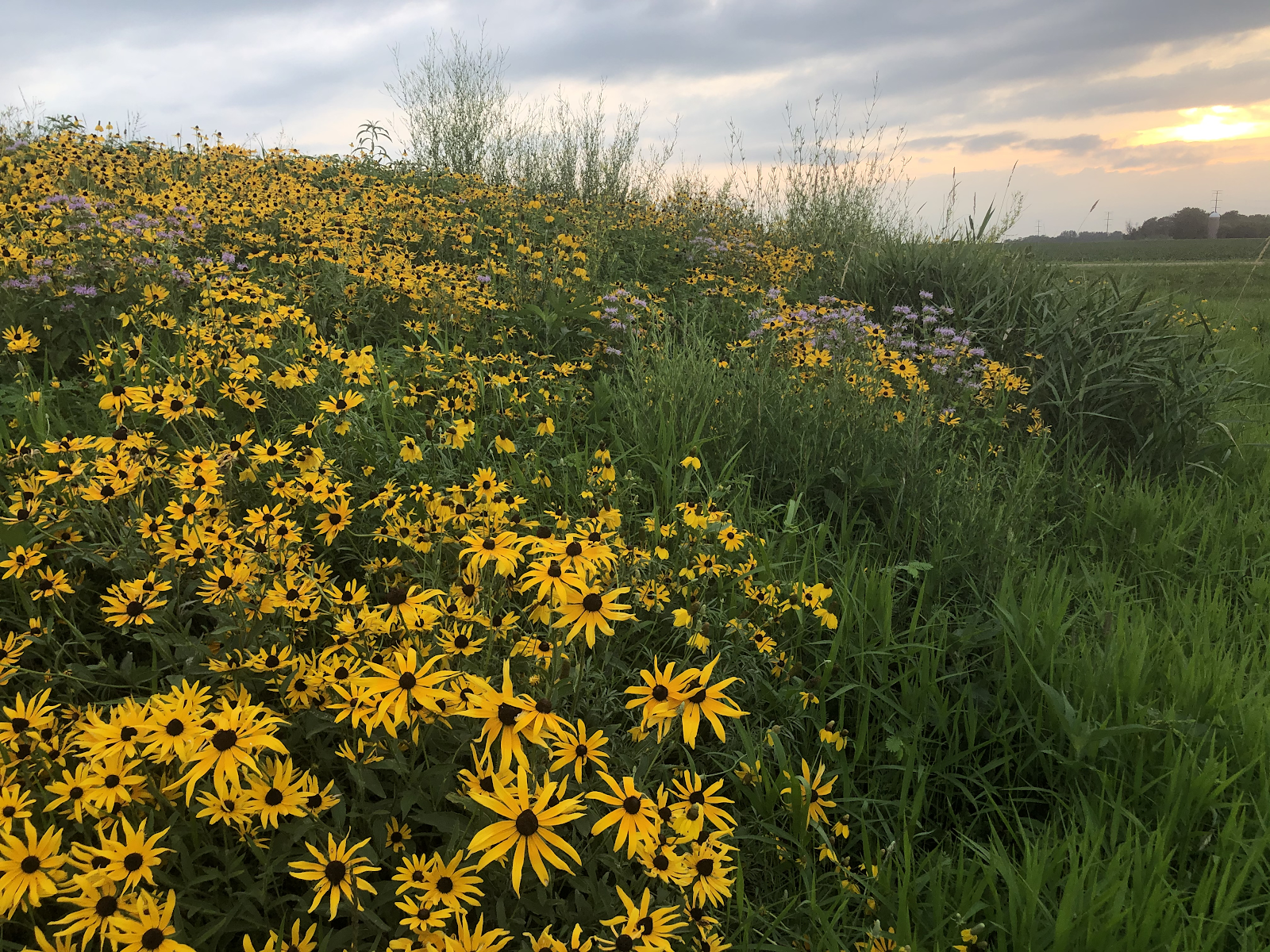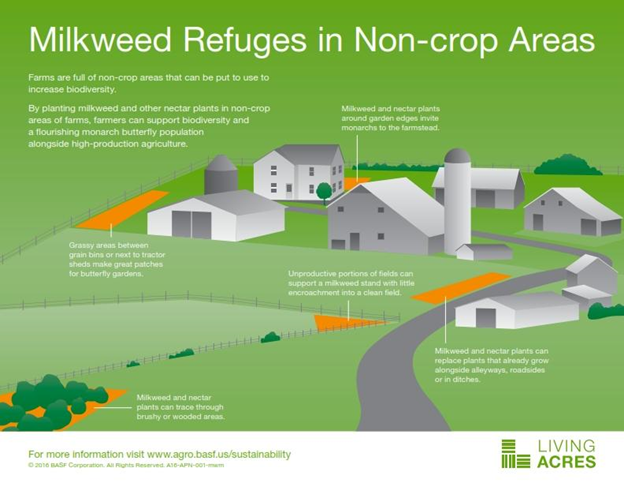
Whether you’re a farmer with an expansive operation, a homeowner looking to beautify a corner of your backyard, or someone looking to develop unused land near roadsides, creating pollinator habitat on non-cropland is a simple way to improve both pollinator and environmental health. Private and even commercial landowners across the country are taking the initiative to develop native pollinator landscaping on nonproductive or marginal lands. We provide a few examples below.
Farmstead
Many farmers include pollinator habitat as part of their overall land conservation ethic. Farmers have considerable capacity to increase pollinator habitat on land near their homes, buildings, silos, and livestock areas. Planting pollinator forage around the farm enhances the landscape, looks great, and has many co-benefits to increasing soil and water quality. Farmers may also be able to save time and money by planting pollinator habitat as it requires less long-term maintenance than mowing grass.
One collaboration between researchers at Iowa State University and the Iowa Pork Producers Association is seeing success as pig farmers develop pollinator habitat on their lands. Iowa’s People, Pigs and Pollinators was established in 2015. Members of the Pork Producers work with Iowa State University researchers to establish pollinator habitat and allow the researchers to survey the habitat plots.
Ben Crawford, environmental services director for Prestage Farms of Iowa, discusses his efforts in the project in the video below.
Roadsides
Roadsides and ditches are great for developing thriving pollinator habitats. Planting monarch habitat in these areas can reduce long-term management costs, save time, and lead to attractive sites and pollinator benefits. If roadsides and surrounding areas are mowed, the land owner should pay attention to beneficial mowing practices. In Cedar Rapids, Iowa, one pollinator friendly organization is converting those unused roadside areas into flourishing pollinator habitats.

The 1,000 Mile Pilot Program of the Monarch Research Project (MRP) will convert 1,000 miles of roadside rights of way to pollinator habitat by 2022. They will plant 75,000 mini-prairies in secondary roadside ditches. Volunteers plant habitat with the expectation that blooms will begin by the second year, and by the third year, the native plants will become mature and dominate the site. According to MRP, students will study the efficacy of this process by monitoring the new green infrastructure for both stem counts and monarch egg counts.
Septic Mounds
Monarch Collaborative member Wendy Caldwell of the Monarch Joint Venture lives in rural Minnesota and utilizes areas of her yard as monarch and pollinator habitat. After installing a new septic mound, it was a perfect opportunity to plant native pollinator habitat onto fresh, already prepared soil. A local native plant producer offered a seed mix specifically designed for septic mounds, making the process even easier! The blanket of blooms during the summer is beautiful and buzzes with pollinators all season long. During the cold winters, the natural habitat holds snow cover that better insulates the mound and prevents freezing.

Preparing Land for Pollinator Habitat
Establishing pollinator is a worthwhile endeavor, but it is not a one-year project.
“It really takes several years to get a good plot established. So, that’s one thing I kept preaching to people in our company. Just have some patience with it,” said Iowa hog farmer Ben Crawford.
Farmers will need to take several steps before planting the habitat and it will take a few years before the habitat to grow and fully bloom. According to Pheasants Forever, management strategies/recommendations for grass field conversions include:
- During Year 1,
- Don’t expect your pollinator seeding to look great. During this time, native wildflowers put most of their energy into root development and will most likely not grow more than a few inches. Some seed sits in the ground for a year before germinating.
- Pollinator seed won’t germinate until ground temperature is 65 – 70 degrees.
- During Years 2-3,
- Pollinator establishment should be coming along
- Once pollinator stand is well-established, start management
- Prescribed burning is the BEST management option; either burn between March 15 – April 15 or September 15 – November 15
Last year, the Keystone Monarch Collaborative hosted a webinar with the Monarch Joint Venture that featured the real-world experiences of farmers establishing habitat adjacent to their working land. Steps include preparing the land using a herbicide for up to two years to eliminate the weed bank and then establishing monarch habitat. The process will take 3-4 growing seasons, but the result looks great and is necessary to rebound this iconic species. We recommend the webinar to anyone interested in developing plots of pollinator habitat.
In addition to this webinar, there are numerous programs available to farmers to help guide them in developing pollinator landscapes. Visit our State Planting Resources page to learn more about these resources and programs.

